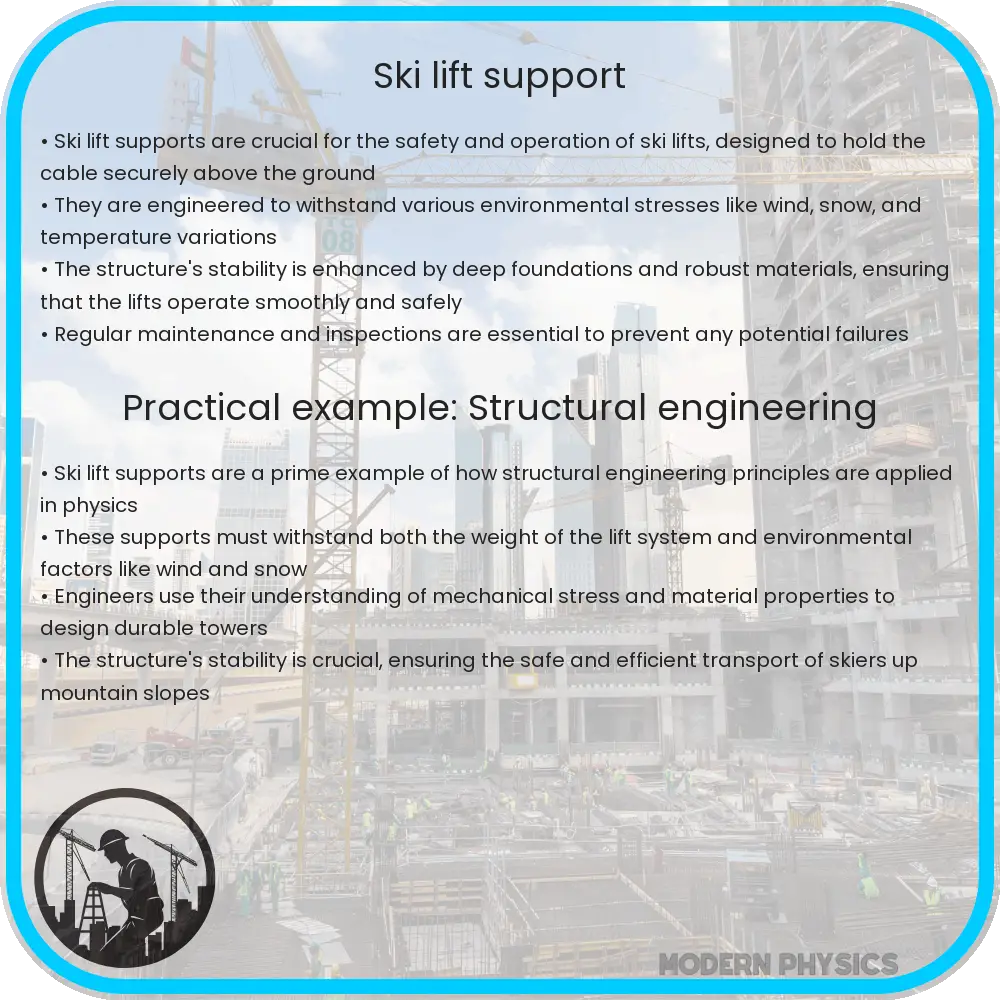Explore the design, safety, and load analysis of ski lift supports, including advanced materials, regulatory standards, and future trends.

Understanding Ski Lift Support Structures: Design and Safety Essentials
Ski lifts are vital components in winter sports, offering a safe and efficient means for skiers and snowboarders to ascend slopes. The design and safety of ski lift support structures are paramount, incorporating advanced engineering principles to ensure reliability and safety. This article delves into the key aspects of ski lift support structures, focusing on their design, safety measures, and load analysis.
Design Principles of Ski Lift Supports
The design of ski lift supports hinges on robust engineering practices. These structures must withstand varied environmental conditions, including heavy snow, strong winds, and temperature fluctuations. The primary materials used in construction are high-grade steel and aluminum, chosen for their strength and resistance to corrosion. The design process involves detailed analysis of terrain, lift path, and expected loads to determine the optimal placement and design of each support tower.
Safety Measures in Ski Lift Construction
Safety is the foremost concern in ski lift construction. Rigorous standards and regulations govern the design and operation of ski lifts. Regular inspections and maintenance are mandatory to identify and rectify any potential issues. Safety features include emergency braking systems, backup power supplies, and evacuation protocols. Additionally, the lifts are equipped with sensors and automatic shutdown systems to prevent accidents.
Load Analysis for Ski Lift Supports
Load analysis is critical in the design and maintenance of ski lift supports. Engineers must account for both static and dynamic loads. Static loads include the weight of the lift components and stationary passengers, while dynamic loads arise from the movement of the lift and environmental factors like wind and snow. Engineers use advanced computational models to simulate these loads, ensuring the structure can withstand the maximum expected load with an adequate safety margin.
Dynamic load analysis also involves assessing the vibrational impact on the structure. Vibrations can lead to metal fatigue, a critical concern in the longevity and safety of the lift. To mitigate this, engineers incorporate dampening systems and select materials with suitable fatigue properties.
Environmental considerations also play a key role in load analysis. The impact of snow accumulation, ice formation, and wind pressure must be carefully evaluated. Special coatings and design features are employed to prevent ice buildup, which can significantly increase the load on the structure.
In summary, the design, safety, and load analysis of ski lift support structures are complex and multifaceted. These aspects are essential to ensure the safe and efficient operation of ski lifts in winter sports facilities.
Advanced Materials and Technologies in Ski Lift Support Design
Technological advancements have significantly enhanced the design of ski lift supports. Modern lifts utilize high-strength, low-weight materials like advanced alloys and composites. These materials offer improved performance in extreme weather conditions and reduce the overall weight of the structure, leading to more efficient designs. In addition, technological innovations in cable dynamics and tension control systems ensure smoother operation and increased safety for passengers.
Regulatory Compliance and Standards
Compliance with international and local safety standards is crucial in ski lift design and operation. Organizations such as the American National Standards Institute (ANSI) and the International Organization for Standardization (ISO) provide guidelines and standards for ski lift construction and maintenance. Adherence to these standards ensures that ski lifts meet the highest safety requirements and are regularly inspected and certified by authorized bodies.
Environmental Impact and Sustainability
Environmental sustainability is increasingly becoming a focus in ski lift design. Eco-friendly practices include using renewable energy sources, such as solar panels, to power the lifts and minimizing the environmental footprint during construction and operation. Designers also strive to integrate the lift structures seamlessly into the natural landscape, preserving the beauty and integrity of the mountain environment.
Future Trends in Ski Lift Design
Looking ahead, ski lift design is poised for further innovations. Emphasis on renewable energy sources and eco-friendly materials is likely to increase. Additionally, digital technologies such as IoT (Internet of Things) sensors and AI-powered maintenance systems could revolutionize the way ski lifts are monitored and maintained, enhancing safety and efficiency even further.
Conclusion
The design, safety, and load analysis of ski lift support structures are critical elements that ensure the safe and enjoyable experiences of winter sports enthusiasts. By combining advanced engineering principles, robust safety measures, and innovative technologies, ski lift designs have evolved to offer high levels of safety and efficiency. Compliance with rigorous standards and a growing emphasis on environmental sustainability further underscore the sophistication of modern ski lift systems. As technology continues to advance, we can anticipate even safer, more efficient, and environmentally friendly ski lift structures in the future, enhancing the appeal and accessibility of winter sports for all.
